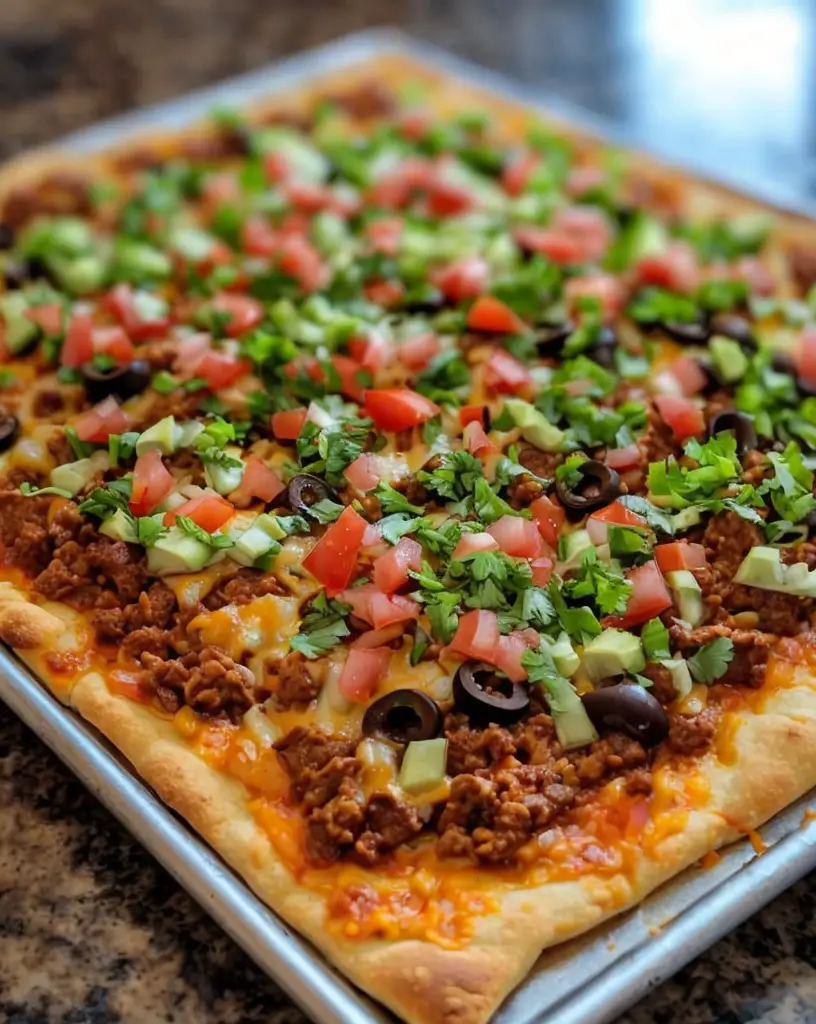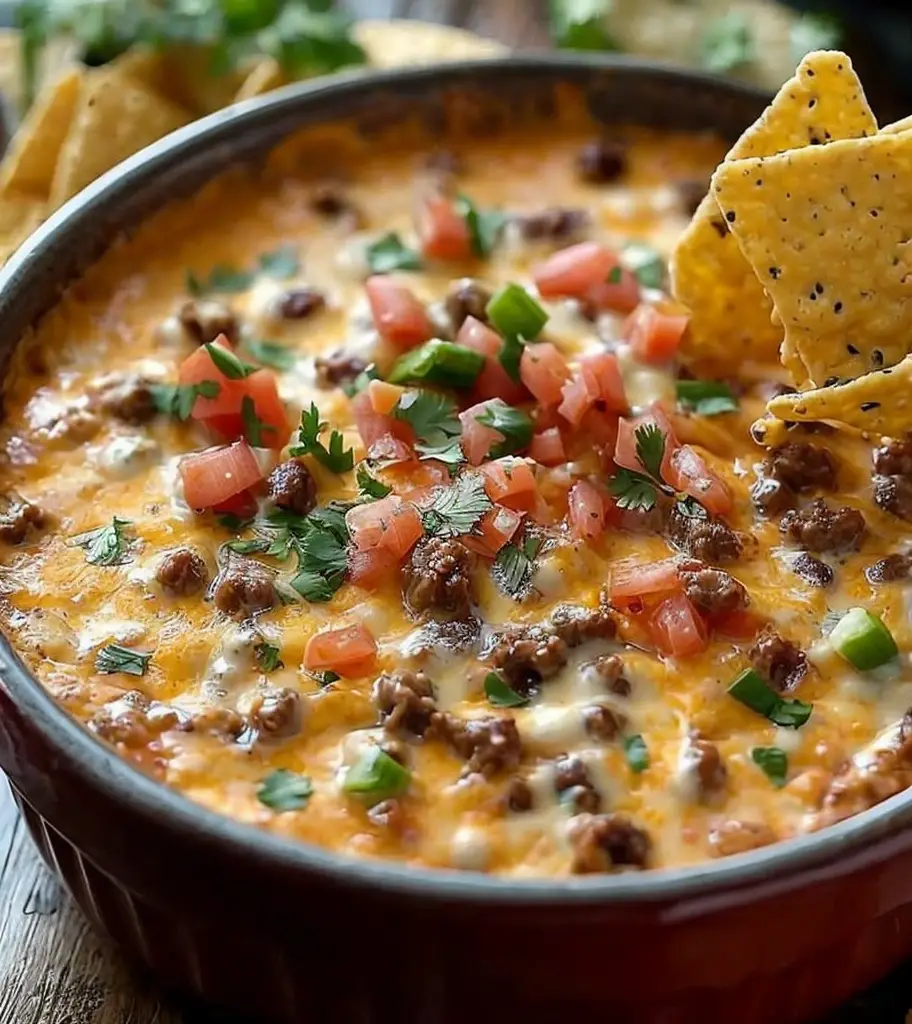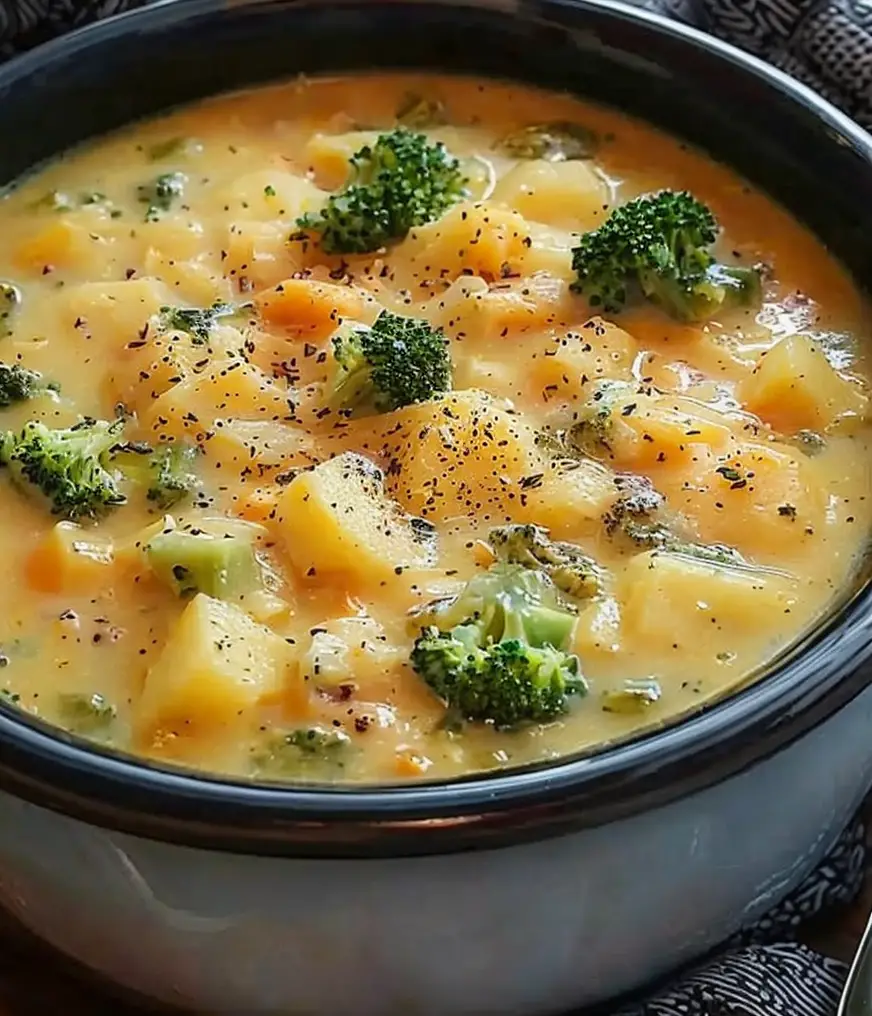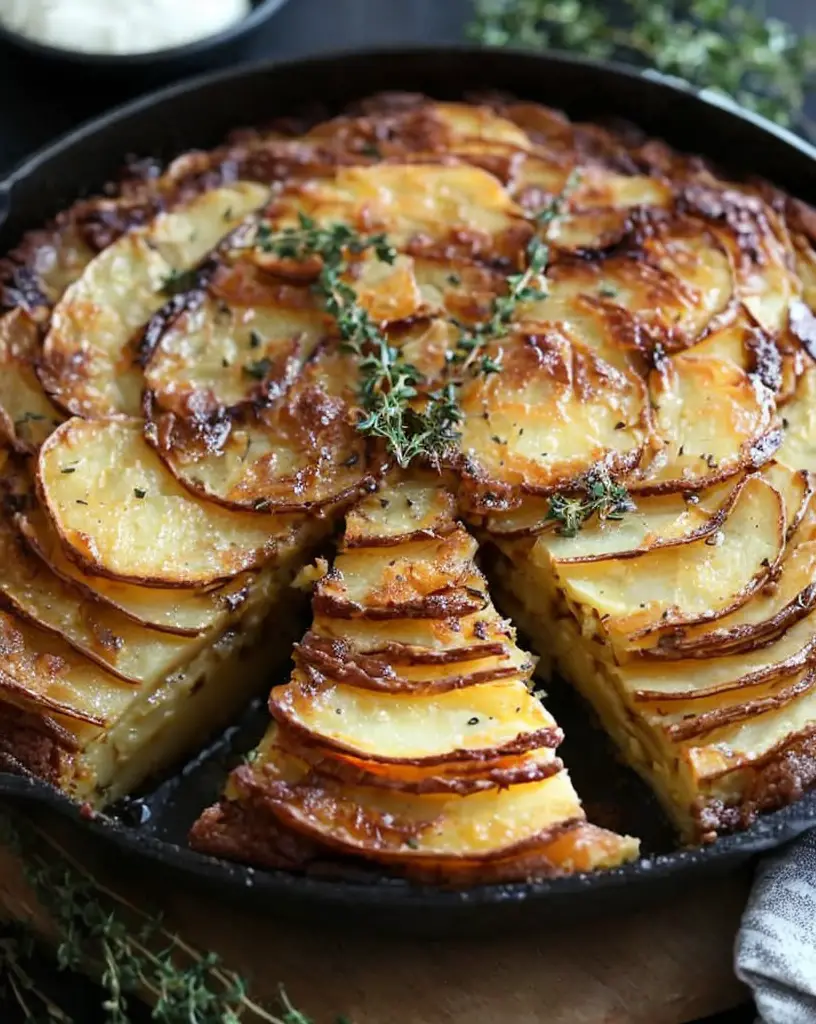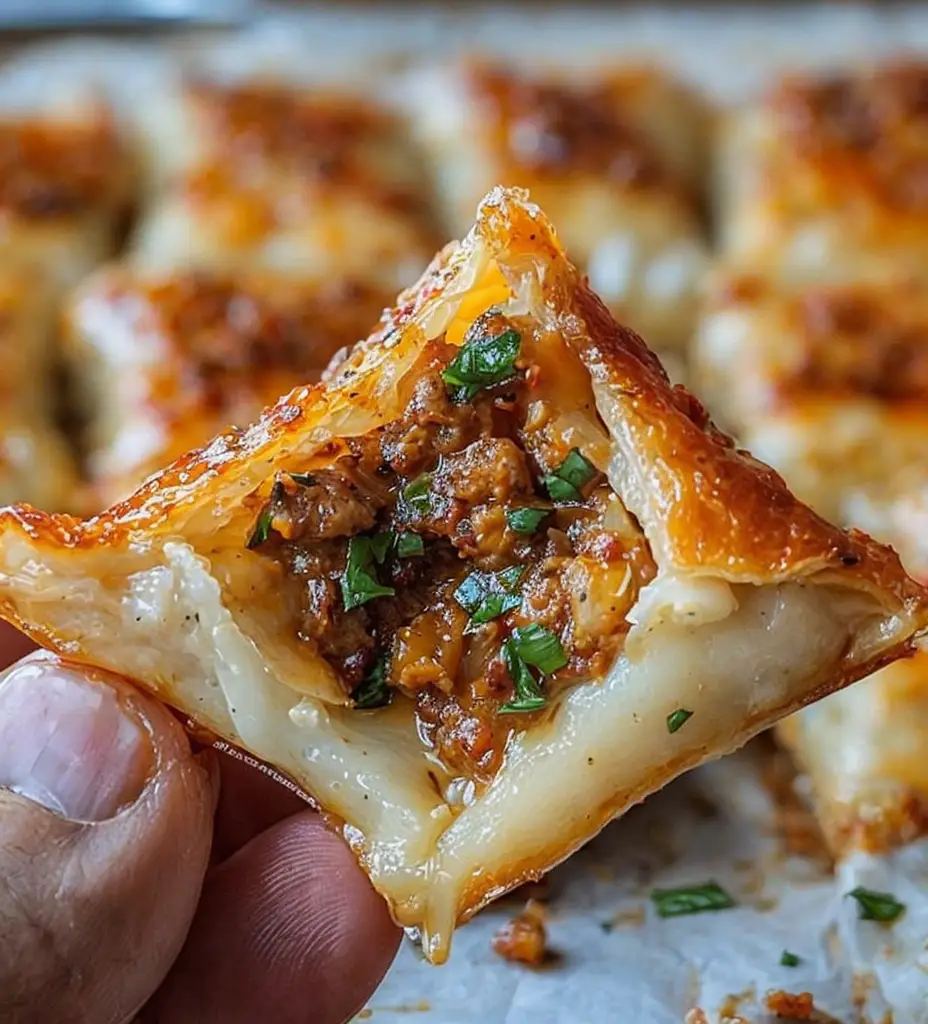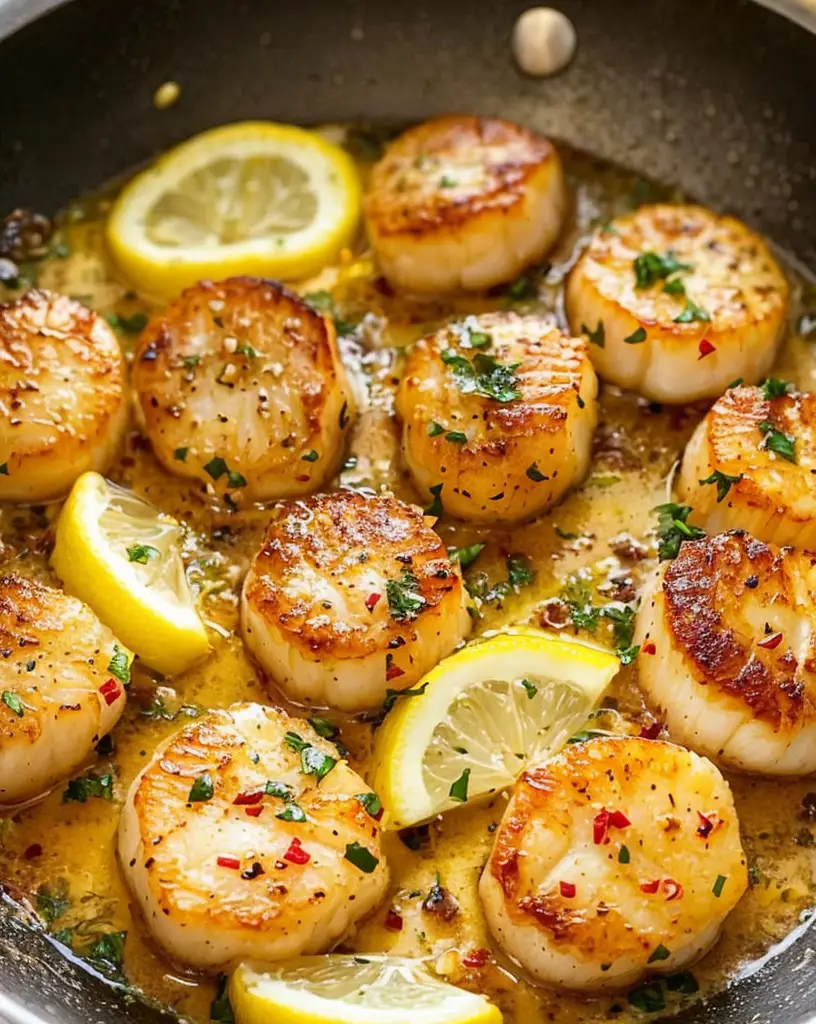Creamy Potato and Bacon Soup: A Heartwarming Delight
Creamy Potato and Bacon Soup is a deliciously indulgent dish that brings comfort and warmth to any meal. This hearty soup combines tender potatoes with crisp bacon, creating a savory flavor profile that is hard to resist. The creamy texture comes from blending the ingredients to a silky smooth consistency, ensuring that every spoonful feels like a warm hug. Perfect for chilly evenings or casual gatherings, this soup is a go-to recipe that showcases the delightful balance of flavors in rustic cooking.
As you take in the steaming bowl of this creamy creation, the aroma of bacon wafts through the air, instantly drawing you in. The rich scent of butter mingling with potatoes creates an inviting atmosphere, making it the perfect recipe to share with family or friends. Each bite is a harmony of creamy potato goodness complemented by the satisfying crunch of crispy bacon, making this soup a satisfying choice that warms both the body and soul.
Quick Recipe Highlights
- Flavor Profile: This soup boasts a harmonious blend of savory bacon, creamy potatoes, and a hint of onion and garlic that creates a delightful umami flavor.
- Texture: The smooth puree of potatoes melds seamlessly with the crunchy bits of bacon, offering a delightful contrast that enhances the eating experience.
- Aroma: The fragrant notes of sautéed onions and garlic create an inviting aroma that delights your senses and whets your appetite.
- Visual Appeal: This dish features a rich, creamy color accented by the golden brown of crispy bacon, making it visually appetizing.
- Skill Level Needed: The recipe is simple enough for beginners while providing enough depth to challenge more experienced cooks.
- Special Equipment: A stick blender or a traditional blender is essential for achieving the creamy texture without losing the heartiness of the ingredients.
Recipe Overview
- Difficulty Level: The creamy potato and bacon soup is easy to prepare, making it ideal for home cooks of all experience levels. Following straightforward steps ensures success in the kitchen.
- Category: This recipe falls under soups and stews, perfect as an appetizer or a comforting main course.
- Cuisine: While rooted in classic American comfort food, creamy potato soup has variations that travel through many cuisines worldwide, showcasing its versatility and appealing flavors.
- Cost: Budget-friendly, this recipe uses pantry staples like potatoes and bacon, ensuring deliciousness without a hefty price tag.
- Season: Ideal for fall and winter months, this soup provides the warmth and comfort needed during colder weather.
- Occasion: Serve this creamy potato and bacon soup as a delightful starter during dinner parties or as a weekday family meal.
Why You’ll Love This Recipe
Creamy Potato and Bacon Soup is more than just a dish; it’s an experience that excites the palate and satisfies the heart. The rich combination of flavors, from salty bacon to buttery smooth potatoes, creates a unique taste that leaves a lasting impression. The comforting nature of this soup ensures that it brings people together, making it perfect for family dinners or cozy meals with friends.
Convenience is another compelling reason to love this soup. Preparation doesn’t take much time, allowing busy cooks to whip up a wholesome meal in less than an hour. You can even prepare it in larger batches to enjoy leftovers throughout the week, making it an efficient dish for meal planning.
Nutritionally, this creamy potato and bacon soup offers comfort without compromising on health. Potatoes are packed with vitamin C and potassium, while bacon adds protein to your diet. Whether served as a main dish or a side, this soup can be part of a balanced meal.
Moreover, this recipe shines during social gatherings. The aroma wafting through the kitchen invites conversation and warmth, making it a perfect dish to share. The simplicity of serving a bowl of creamy soup makes it a hassle-free choice for entertaining.
Lastly, this soup is cost-effective. With accessible ingredients that you likely already have on hand, you can create a delicious meal without overspending. It’s an excellent choice for families or anyone looking to enjoy homemade comfort food without breaking the bank.
Historical Background and Cultural Significance
The origins of potato soup can be traced back centuries to various culinary traditions across Europe, where potatoes were a staple food due to their versatility and ease of cultivation. With the arrival of bacon in European cuisine, often used as a prized ingredient, the two came together brilliantly, resulting in what we now cherish as creamy potato and bacon soup.
Culturally, this dish symbolizes comfort and practicality, often served in homes as a hearty meal. Its simplicity speaks to resourcefulness, allowing home cooks to utilize leftover ingredients effectively—hence forming a comforting staple in many kitchens.
The evolution of this recipe is fascinating; the original versions were likely handcrafted with whatever ingredients were available. Today, variations allow for creativity, reflecting regional flavors and preferences, from adding cheese to incorporating local herbs.
Furthermore, various regions have embraced unique spins on potato soup, telling stories of their local ingredients and culinary approaches. From regional spices to diverse preparation methods, each version adds to the soup’s rich tapestry, affirming its status as a beloved dish worldwide.
Ingredient Deep Dive
– Potatoes: A cornerstone of this recipe, potatoes are a nutrient-dense food that offers carbohydrates, fiber, and essential vitamins. When selecting potatoes, opt for starchy varieties like Russets or Yukon Golds for better texture. Store in a cool, dry place and avoid exposure to direct light to prevent sprouting.
– Bacon: As the soul of this soup, bacon adds a rich umami flavor and enticing aroma. The nutritional benefits of bacon include high protein and certain essential vitamins. Choose high-quality bacon for the best results. To ensure longevity, keep bacon refrigerated and consume it by the sell-by date for optimal freshness.
Common Mistakes to Avoid
- Overcooking the Potatoes: This can lead to a mushy texture; instead, cook them until just fork-tender for optimal consistency.
- Not Blending Enough: A smooth puree enhances the creaminess; blend thoroughly, adjusting the consistency with broth as needed.
- Using Low-Quality Bacon: This can lead to a bland flavor; choose thick-cut, high-quality bacon for maximum taste and texture.
- Skipping the Aromatics: Failing to sauté onions and garlic beforehand lacks the foundational flavor; always sauté to build depth.
- Overseasoning: Adding salt too early can intensify flavors; season gradually and taste as you go to achieve the perfect balance.
- Rushing the Cooking Process: Allowing flavors to develop through slow cooking enhances the overall taste of the soup.
- Not Adjusting for Creaminess: If the soup isn’t creamy enough, add additional cream or milk gradually to achieve the desired richness.
- Neglecting Portion Sizes: Be mindful of serving sizes to avoid wastage and ensure everyone enjoys a satisfying bowl.
Essential Techniques
– Sautéing: This is crucial for flavor development. Start with medium heat and add butter or oil to the pan, cooking onions until translucent. Avoid high heat to prevent burning while achieving that essential sweet flavor.
– Blending: Whether using a stick blender or traditional blender, achieving the perfect smoothness is vital. If using a traditional blender, blend in batches, allowing steam to escape to avoid overflow—always remember to secure the lid tightly.
Pro Tips for Perfect Creamy Potato and Bacon Soup
1. Use a mix of potato types for added flavor and texture, incorporating waxy varieties that preserve their shape and creamy ones for smoothness.
2. For extra creaminess, consider adding cream cheese or sour cream after blending; this elevates the soup’s richness.
3. To enhance the smoky flavor, try using pancetta or smoked bacon as a substitute for traditional bacon.
4. If you enjoy subtle heat, add a pinch of cayenne pepper or red pepper flakes during cooking, balancing the flavors beautifully.
5. Incorporating herbs such as thyme or rosemary can elevate the dish’s aroma and add a touch of freshness to the soup.
6. Garnish with chopped fresh chives or crispy bacon right before serving for added flavor and visual appeal.
7. Adjust the thickness of the soup by varying the amount of broth; for a thicker soup, reduce the liquid incrementally until desired texture is achieved.
8. Pair it with crusty bread for a perfect meal that combines the warmth of the soup and delightful crunch of the bread.
Variations and Adaptations
For a regional twist, consider adding local spices or ingredients, such as cheddar cheese for a sharp bite or chopped kale for a nutritional boost. Seasonal adaptations might include using pumpkin or butternut squash during fall, altering the soup’s flavor while keeping the creamy base intact.
Dietary modifications can also cater to different preferences; for gluten-free options, ensure your chicken broth is labeled gluten-free, or use vegetable broth for a vegetarian version. Flavor variations include adding roasted garlic for depth or smoked paprika for a cheery kick. Tex-mex flavors can be introduced by spicing up the dish with chilies, lime, and cilantro.
For texture, try incorporating various toppings, like toasted croutons for crunch or a dollop of herbed yogurt for creaminess and visual contrast. Presentation can also be adapted by serving in unique bowls or utilizing edible garnishes to heighten the visual appeal.
Serving and Presentation Guide
Plating your creamy potato and bacon soup beautifully elevates the dining experience. Consider using deep bowls to create a comforting vibe while ensuring ample space for garnishes. You can spiral a bit of cream atop the soup for flair, or drizzle a bit of olive oil for an aromatic touch.
Garnishing is essential—chopped chives or parsley can enhance color, while crispy bacon bits add an enticing crunch. Pair with warm, crusty bread for dipping, encouraging a homely atmosphere, perfect for family gatherings.
Temperatures should be served hot, as creamy soups lose charm when cooled, though they can be enjoyed warm as leftovers. To ensure portion control, serve smaller bowls, allowing guests to sample alongside other delightful dishes.
Wine and Beverage Pairing
When considering wine pairings for creamy potato and bacon soup, opt for a medium-bodied white wine like Chardonnay, which can complement the creaminess without overpowering the dish. A light Pinot Noir can also work beautifully, bringing in additional flavors of earthiness and depth.
For non-alcoholic alternatives, serve sparkling water with a slice of lemon or a herbal iced tea to refresh your palate without being too heavy. If coffee or tea is your preference, opt for a light herbal tea to balance the richness of the soup. When serving, ensure beverages are at the right temperature, enhancing the overall dining experience.
Storage and Shelf Life
To store creamy potato and bacon soup, let it cool before transferring it to an airtight container. This soup can typically be stored in the fridge for up to 4 days. Ensure it is kept at a temperature below 40°F for maximum preservation.
For longer storage, consider freezing the soup. Use freezer-safe containers, leaving space for expansion, as the soup will freeze solid and keep for 2-3 months. When reheating, thaw it overnight in the fridge for best results, and gently heat on the stovetop while stirring to maintain creaminess, adjusting the thickness with broth as needed.
Signs of spoilage include off odors, unusual colors, or separation in the mixture. If there’s any doubt about the freshness, it’s best to discard the soup.
Make Ahead Strategies
For efficient meal preparation, consider making creamy potato and bacon soup in advance. Start by prepping the ingredients a day before, peeling and chopping potatoes and bacon, and storing them in the refrigerator. This saves valuable time on cooking day.
You can also prepare the entire soup base and then allow it to cool before refrigerating. When you’re ready to serve it, simply reheat the soup, adjusting the consistency as required by adding cream or broth. Consider supplementing freshness by adding chopped herbs right before serving for a burst of flavor.
In terms of quality, reheating may cause the soup to thicken; feel free to add a splash of broth to restore consistency. Make sure fresh ingredients like herbs or garnishes are added just before serving to maintain their vibrancy.
Scaling Instructions
Scaling the recipe for more or fewer servings is straightforward. If you plan to halve the recipe, ensure you keep the proportions consistent to maintain flavor integrity. Similarly, doubling or tripling will still yield a delicious result; just be cautious about overcooking or adjusting time on larger batches.
Equipment adjustments may be necessary, especially when scaling up; use larger pots or additional cooking tools to accommodate the increased volume. Timing modifications might also be required, as larger batches may need more time to reach the desired tenderness. Storage considerations also change—ensure you have sufficient container space to store larger amounts effectively.
Nutritional Deep Dive
The creamy potato and bacon soup offers a balanced macro breakdown. A typical serving contains carbohydrates primarily from potatoes, protein from bacon, and fat primarily from cream and butter. The balance of these macros makes it a filling meal option.
Micronutrient analysis reveals that potatoes are a good source of vitamins C and B6, alongside potassium. Bacon provides essential B vitamins, while the optional cream adds vitamin A and D. As it comes together, this soup offers nutritional value without sacrificing flavor.
While creamy in nature, it can be part of a well-rounded diet when matched with fresh veggies or whole grains on the side. The richness provides satiety, making it an excellent option for maintaining energy levels throughout the day.
For weight management, however, portion control is key. Serve smaller bowls and incorporate a salad or vegetables to accompany the soup, ensuring balanced meals without excess calories.
Dietary Adaptations
For gluten-free adaptations, ensure all ingredients are gluten-free, including any stock or broth used. A dairy-free version can easily be made by substituting cream with coconut milk or cashew milk and using non-dairy bacon alternatives.
Vegan adaptations are possible as well; replace bacon with smoked tempeh or mushrooms, and ensure plant-based substitutions for cream and broth. For low-carb options, swap potatoes for cauliflower, blending until smooth to create a similar texture.
Keto adaptations align with reducing carbohydrates—prioritize lower-carb vegetables while maintaining creamy richness with cheese or heavy cream for texture. Many people also find joy in paleo diets, simply replacing conventional ingredients with whole, unprocessed options while maintaining the essence of the soup.
Troubleshooting Guide
Texture issues can often arise with creamy potato and bacon soup. If it feels too gritty or chunker, kick the blending into high gear for a silkier finish. Taste balance is another common issue; if the soup seems too salty, adjust by adding a splash of water or adding unsalted broth to bring everything back into harmony.
Temperature problems, such as soup being too thick, can be remedied by adding additional broth or milk. On the other hand, if it’s too thin, let it simmer uncovered to reduce excess liquid.
If you substituted ingredients but the flavor is lacking, enhance it by incorporating additional spices or aromatics, adjusting each to build a flavor profile that pleases your palate. Equipment challenges, like using an insufficient blender, can result in inconsistent consistency; always ensure you have the right tools for the job.
Timing concerns often stem from over or undercooked potatoes; start checking for doneness earlier in the cooking process, ensuring they remain tender and fluffy.
Recipe Success Stories
Community feedback for creamy potato and bacon soup highlights its universal appeal. Many home cooks rave about how easy it is to modify to personal taste, resulting in unique variations that delight friends and family. Some have even shared their success in making the soup gluten-free or dairy-free, showcasing its versatility.
Readers often come back to share their tips for adding extra ingredients like cheese or herbs, enhancing the dish based on their culinary preferences. Additionally, many enjoy taking show-stopping photographs as they showcase their finished bowls, which often garners compliments from social media followers.
Adaptation stories also abound; one reader’s addition of leeks led to a delightful twist that intrigued her family. Such success in variations contributes to a collective sense of community, where cooks can experiment and have fun while still maintaining the original essence of this beloved soup.
Frequently Asked Questions
2. How can I make the soup vegan? To make this soup vegan, you can substitute bacon with smoked tempeh or mushrooms and replace cream with coconut cream or cashew cream.
3. Is it necessary to peel the potatoes? Peeling is not required; leaving the skins on can add additional nutrients and texture. Ensure to clean them well if you choose to keep the skin.
4. Can I make this soup in a slow cooker? Absolutely! Start by sautéing the onion and garlic, then add all ingredients into the slow cooker and set it on low for 6-8 hours or high for 3-4 hours.
5. What is the best type of potato for this recipe? Starchy potatoes like Russet or Yukon Gold work best for a creamy texture while retaining flavor. Waxy potatoes may not yield the same consistency.
6. Can I make this soup spicier? Absolutely! Feel free to add red pepper flakes or cayenne pepper for a subtle kick. Adjust to your preferred heat level.
7. How do I know when the potatoes are done cooking? Potatoes are properly cooked when they are easily pierced with a fork but remain intact enough to hold their shape.
8. Can I use another type of meat in this recipe? Yes, smoked sausage or ham are excellent substitutes for bacon and will provide a similar rich flavor profile.
9. How should I store leftover soup? Store leftovers in an airtight container in the refrigerator for up to 4 days. To extend its life, consider freezing portions for later consumption.
10. What’s the best way to reheat the soup? Reheat the soup gently on the stove over medium-low heat. Stir frequently and add a bit of broth if it’s too thick when reheating.
Additional Resources
For those who want to explore further, try related recipes like classic tomato basil soup or chicken noodle soup for more comforting options. Technique guides for blending or sautéing can also aid your culinary skills. Understanding various ingredient properties, such as which potatoes to use or types of bacon available, can further enhance your cooking repertoire.
Equipment recommendations include using a high-quality blender for smooth textures or a great cast iron pot for even heating during cooking. Lastly, seasonal variations can include using ingredients like pumpkin or squash during fall for a delicious twist on this comforting classic.
Join the Conversation
We love hearing from our readers! Share your creations with us on social media and join the conversation by tagging us in your photos. Whether it’s a modification you made to the recipe or a perfect match with a side dish, your feedback helps build a community of passionate cooks.
Photography tips can help improve images of your delicious soup, allowing you to showcase your culinary accomplishments. Recipe reviews from your experience cooking this creamy potato and bacon soup also contribute to a knowledge base that helps others recreate this beloved dish.
Feel free to suggest recipe variations that you’ve discovered or ideas for additional ingredients, encouraging fellow readers and enriching our culinary community together.
The Recipe
Creamy Potato and Bacon Soup
Serves: 4 bowls
Prep Time: 15 mins
Cook Time: 30 mins
Total Time: 45 mins
Kitchen Equipment Needed
- Large pot or Dutch oven
- Stick blender or traditional blender
- Cutting board
- Knife
- Measuring cups and spoons
Ingredients
- 4 large Russet potatoes, peeled and diced
- 5 slices of bacon, chopped
- 1 medium onion, diced
- 2 cloves garlic, minced
- 4 cups chicken or vegetable broth
- 1 cup heavy cream
- Salt and pepper to taste
- Fresh chives for garnish
Directions
- In a large pot, cook the bacon over medium heat until crispy. Remove bacon and set aside, leaving bacon grease in the pot.
- Add diced onion and garlic to the pot, and sauté until softened and fragrant, about 3-5 minutes.
- Add diced potatoes and broth to the pot, bringing to a boil. Reduce heat and simmer for 20 minutes, until potatoes are fork-tender.
- Using a stick blender, puree the soup until smooth. If using a traditional blender, allow the soup to cool slightly before blending in batches.
- Return the pureed soup to the pot, stir in the heavy cream, and adjust seasoning with salt and pepper.
- Serve hot, garnished with crispy bacon and fresh chives.
Recipe Notes
- Feel free to add additional spices or herbs to suit your taste.
- For a lower fat version, replace heavy cream with half-and-half or non-dairy milk.
- Consider adding cheese for a cheesy twist; cheddar pairs especially well!

